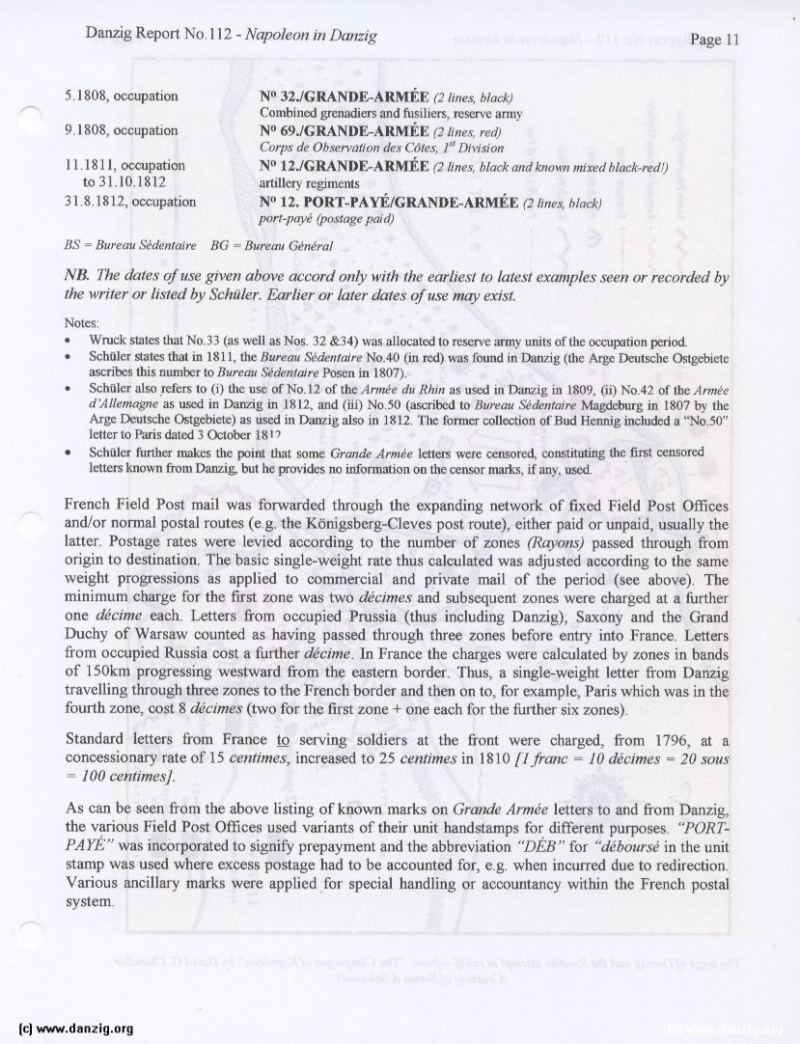
Notes:
• Wruck states that No.33 (as well as Nos. 32 &34) was allocated lo reserve army units of the occupation penod.
• SchUler states that m 1811, the Bureau Sédentgure No.40 (in red) as found in Danzig (the Arge Deutsche Osigebiete ascribes this number to Bureau SEdenlaire Rosen in 1807).
• Schülcr also refers to (i) dic use of No.12 of the Arméc du Rhin as used in Danzig in 1809. (ii) No.42 of the ArmEe dAllemagne as used in Danzig in 1812. and (iii) No.0 (ascnbed In Bureau SEdentaire Magdeburg in 1807 by the Arge Deutsche Oatgebietc) as used in Danzig also in 1812. [tie former collection of Bud Hennig included a “No.50” letter to Paris dated 3 October 1812
• Schüler further makes the point that some Graude Armée idlers were censored, constituting the first censored letters knol4il from Danzig. but he provides no information on the censor marks, if any, used.
French Field Post mail was forwarded through the expanding network of fixed Field Post Offices andlor normal postal routes (e.g. the Kongsberg-Cleves post route), either paid or unpaid, usually the latter. Postage rates were levied according to the number of zones (Rayons) passed through from origin to destination. The basic single-weight rate thus calculated was adjusted according to the same weight progressions as applied to commercial and private mail of the period (see above). The minimum charge for the first zone was two ckcimes and subsequent zones were charged at a further one décime each, Letters from occupied Prussia (thus including Danzig), Saxony and the Grand Duchy of Warsaw counted as having passed through three zones before entry into France. Letters from occupied Russia cost a further décime. In France the charges were calculated by zones in bands of 150km progressing westward from the eastern border. Thus, a single-weight letter from Danzig travelling through three zones to the French border and then on to, for example, Paris which was in the fourth zone, cost 8 clécimes (two for the first zone + one each for the further six zones).
Standard letters from France serving soldiers at the front were charged, from 1796, at a concessionary rate of 15 cenilmes, increased to 25 centime.s in 1810 [1 franc = 10 décimes = 20 sotis 100 cenhimes).
As can be seen from the above listing of known marks on Grandt’ Arrnt’e letters to and from Danzig. the various Field Post Offices used variants of their unit handstamps for different purposes. “PORTP A YE” was incorporated to signify prepayment and the abbreviation “DEB” for “déboursé in the unit stamp was used where excess postage had to be accounted for, e.g. when incurred due to redirection. Various ancillary marks were applied for special handling or accountancy within the French postal system.
Danzig Report Vol. 1 - Nr. 112 - July - August - September - 2001, Page 11.
Hits: 3320
Added: 30/07/2015
Copyright: 2025 Danzig.org

